
History
The beginnings of modern Nuwara Eliya were essentially British. Uninhabited when the British came to Ceylon, it was accidentally discovered by Dr. John Davy, brother of Sir Humphrey Davy, the famous chemist while on a hunting party in 1818, and was made into a health resort and sanatorium for British officials in 1828 by Sir Edward Barnes, the Governor of the Island at the time. Barnes incidentally built a mansion for himself. “Barnes Hall”, which today, after considerable alterations exists as the Grand Hotel. The town itself did not extend beyond some amenities for the military and a few residential and other buildings, until the arrival in 1847 of Sir Samuel Baker. Baker was an explorer and entrepreneur who established a settlement in Nuwara Eliya, and went to the extent of importing all the appurtenances of an English country town.

The planting of coffee, and after its failure, the opening up of tea plantations on the hills of Nuwara Eliya brought in their wake the trappings of the commercial world, and during the latter half of the 19th century, Nuwara Eliya was transformed “from a wild open plain into a busy British hamlet”. It became then, as it is now, essentially a holiday resort. It's cool and invigorating climate, and its location, only a few hours from the tropical heat of the capital, Colombo, made it irresistible - first to the British and then to the Ceylonese. As more residences were built (copying “Old English” architectural styles) British sports and recreations were introduced – golf, tennis, horse-racing, cricket, croquet, hunting and trout fishing. From the early part of this century it became fashionable to spend April, the hottest month of the year, in Nuwara Eliya. A “Queen’s Cottage” was established as a holiday residence for the British Governor and his retinue. With the Governor at “Queen’s Cottage” each year, first British residents and in later years the Ceylonese elite, flocked to the hill resort for “The Season”. The whole town came alive as a glittering programme of social and sporting events was laid on for the holidaymakers.
But Nuwara Eliya was not unknown to the early Sinhalese. Literally translated, the name means “The City of Light”. The earliest record of the name appears in the map in Robert Knox’s account of Ceylon published in 1681. Lithic inscriptions on granite were discovered in Nuwara Eliya by H. C. P. Bell, the Archaeologist, suggesting the existence of a Buddhist Vihare there in the 10th Century A. D. Another theory suggests that Nuwara Eliya means “Royal Plains”, supposedly because the ancient kings of the Royal City of Kandy depended on its streams for their water supply, and laid claim to the precious gems discovered there. Nuwara Eliya was also supposed to have deposits of gold and prospecting for this precious metal has been intermittently, and unsuccessfully, carried out even to recent times. There is also evidence that it was used as a resting place by an adventurous traveller or two in the Portuguese and Dutch periods of occupation of the island and one story is that Dona Katherina took temporary refuge in Nuwara Eliya when she was driven from her Capital by the Portuguese in 1628. Nuwara Eliya ostensibly has a place in Sinhalese and Hindu legend through the Ramayana, the epic relating the story of Rama and Sita. When the beautiful Queen Sita, wife of King Rama whose kingdom was in India, was abducted by Ravana, the Demon King of Ceylon, she was held in captivity close to the town until she was rescued by Hanuman, the Monkey King. This area is called Sita-Eliya after the beautiful Queen.
Year 1900
E. M. de C. Short, the Assistant Government Agent of Nuwara Eliya, in his report refers to the improvements that were carried out in Nuwara Eliya.”The plain is steadily progressing, both in appearance and public utility. With the help of prison labour, it now comprises of one of the best, if not the best, cricket grounds in the island, besides excellent grounds for polo, hockey, tennis, golf and croquet, not to mention the fine race course which the Gymkhana Club has, at great expense and trouble, succeeded in constructing”, adding, “The entire aspect of the tract of swampy ground lying between the Grand Hotel and Church Road has been changed during the year. The swamps have been drained, rank vegetation cleared, trees thinned and lopped, and the ground laid out on one side as golf links, and on the other as a public park”.
The Board of Improvement undertook to drain the swamp and the Club, for its part, voted a sum of Rs.1,999 for the extension of the links in the direction of the Grand Hotel. The election of members by ballot was introduced. At the Annual General Meeting, it was announced that the credit balance amounted to Rs. 2,959 and that Rs. 2,679 had been expended, including the cost of upkeep of the Greens.
C. Brooke-Elliot, a leading advocate from Colombo who was also the earliest historian of the Colombo Golf Club, made his debut at Nuwara Eliya, winning the championship and the Captain’s Cup — a cup presented by Sir West Ridgeway. In the finals of the championship, he beat Robert Meaden of the Victoria Golf Club, who afterwards earned a name for himself on the Ceylon turf.
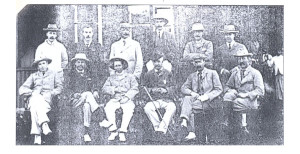 While the introduction to this History traces the establishment of Nuwara Eliya as a holiday resort, it must be remembered that the journey from Colombo to Nuwara Eliya in the early days took several days. The road from Kandy to Nuwara Eliya was made passable for horses only in 1827, became a cart road in 1836, and was macadamised in 1879. The railway was extended to Nanu Oya in 1885, and unless one travelled up by train, the journey by horse-drawn coach was a tedious one.
While the introduction to this History traces the establishment of Nuwara Eliya as a holiday resort, it must be remembered that the journey from Colombo to Nuwara Eliya in the early days took several days. The road from Kandy to Nuwara Eliya was made passable for horses only in 1827, became a cart road in 1836, and was macadamised in 1879. The railway was extended to Nanu Oya in 1885, and unless one travelled up by train, the journey by horse-drawn coach was a tedious one.
With the opening of the light railway, popularly known as the ‘toy train’ from Nanu Oya to Nuwara Eliya in 1903 and the advent of the motor car to the island a year later, travel to Nuwara Eliya was revolutionised. By the end of 1904, there were 21 motor cars in Ceylon, the speed of these cars varying from 10-25 m.p.h. When “Mr. Davidson drove his Beaufort from Colombo to Nuwara Eliya in 12 hours”, it was considered a ‘dare-distance’ feat! More was soon to follow, and “Walkers imported 10-seater Albion buses for hire which were in great demand for week-end trips up-country”. Regarding the railway, all the personnel employed, from engine drivers and guardsmen, were recruited from Britain and their salaries were paid in sterling.
A special General Meeting in Nuwara Eliya at which the Captain of the Colombo Golf Club was present, was held in 1904, and on a show of hands, the members had voted for only one championship a year, the only dissenting vote being that of the Captain of the Nuwara Eliya Golf Club, the Hon. J. N. Campbell. His reason was the difficulty the up-country player had in getting to Colombo and vice versa, and he believed it was only fair to have a championship in each centre every year. However, with transport becoming easier, the other members no doubt felt that this could no longer be accepted, and it was time to run the championship yearly on the internationally accepted basis.
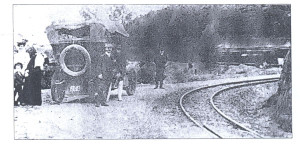 In April, 1904, ‘The Times’ reported that all of Colombo was in Nuwara Eliya, and that there were no less than 12 players off scratch. The tournaments were held over 12 holes, as the four holes below the Hill Club were not yet fit for play. The Grand Hotel extension was opened in September 1904, in time for the ‘Tee Valli’ Meet. ‘The Times’ reported that during this Meet, a coolie was fined Rs.1 for stealing a plank from a bridge on the course.
In April, 1904, ‘The Times’ reported that all of Colombo was in Nuwara Eliya, and that there were no less than 12 players off scratch. The tournaments were held over 12 holes, as the four holes below the Hill Club were not yet fit for play. The Grand Hotel extension was opened in September 1904, in time for the ‘Tee Valli’ Meet. ‘The Times’ reported that during this Meet, a coolie was fined Rs.1 for stealing a plank from a bridge on the course.
In 1905, the First Championship under the new conditions was held in Nuwara Eliya and two Colombo Golfers figured in the Final which was won by C. T. Young. Captain J. N. Campbell was again elected Captain, which led to a curious letter signed ‘Fairplay’ appearing in ‘The Times of Ceylon’ which included “the Colombo Golf Club elects a new President and Captain each year in keeping with the traditions of the best Golf Clubs, but the present Captain of Nuwara Eliya has held the Post for 15 years which has led to the question being asked, ‘How much longer will the present Captain hold on to the honour before he intimates his wish to see some other Member have a turn? A little new blood will not do Nuwara Eiiya any harm, though I do not wish to ignore the good work done by the residents and the Captain himself”.
The Course at this time was described as a “varying and sporting one from the first drive to the last putt, the turf was gloriously green and springy at every point, while the Club House was admirably located.” It was about this period that the rubber-core ball replaced the gutties and a correspondent commented that the gar was lost in science and had been made easier, but easiest of all to the weak.
In 1910, J. N. Campbell wh,o had been Captain for 13 years in succession, gave up that Office. A tribute to his services was paid at the Annual General Meeting. A new Rule was carried unanimously at the Meeting regarding the procedures to be adopted in the pro¬posing, balloting for and election of Members.
The need for the employment of a professional was discussed at some length. The Nuwara Eliya Club suggested that the services of a professional was desirable, but that as there was insufficient employment for a full-time professional in Nuwara Eliya, a discussion took place with the Colombo Golf Club regarding the possibility of sharing the services of a professional. The matter was dropped as the Colombo Golf Club was not interested.
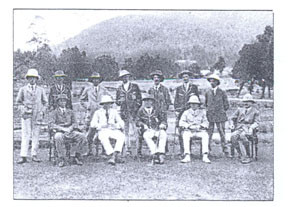 Another matter that was brought up was the question of the Women’s Golf Trophy. Hitherto, the Cup had to be won five times to become the property, outright, of the Winner. This was considered too long, and the Rule was altered to three wins, not necessarily in succession.
Another matter that was brought up was the question of the Women’s Golf Trophy. Hitherto, the Cup had to be won five times to become the property, outright, of the Winner. This was considered too long, and the Rule was altered to three wins, not necessarily in succession.
The foursomes were won by Brig-Gen. A. J. Whitacre-Allen, G. O. C. Troops in Ceylon, partnered by H. H. Phelp. The Sylvester Vase was annexed by P. J. Hawkes. Smallwood won his second Ceylon Title at the Ridgeways, and Sir Joseph Hutchinson, the President of the Colombo Golf Club, in presenting the Cup, said that while some of their friends, Up-country, were of opinion that they could not be beaten on their own links, he hoped Smallwood would go up to Nuwara Eliya the following year and show that he was not second to anybody. Other items of interest reported in The Times were that the Crown Prince and Princess of Germany played on the Nuwara Eliya Course in November, and that the Golf links of the United Club in Nuwara Eliya were extended and improved.
Year 1901 – 1903
In 1901, the first known Rules and Constitution of the Club was printed, a copy of which is still available, (Looking through this booklet, one finds that these Rules, and also the basic R & A Rules of Golf, have changed remarkably little over the years).
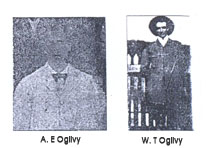
The brothers, A.E. and W.T. Ogilvy (known as Big and Little Og respectively), planters in the Uva District, made history during the three years, 1901-1903. A. Ogilvy, who was also a brilliant rugger forward, won championships in Nuwara Eliya in 1901, and repeated his success the following year. He was the father of Walter Ogilvy, a very popular Captain of the Club in 1964, ’67 and ’68. (Incidentally, Ferguson’s Directory of 1919 records that A. E. Ogilvy shot a rogue elephant near Alutnuwara that year). W. T. Ogilvy won the championship in 1903. It was also the year the Haskell ball was used in the championship, and an amusing incident occurred during the finals when a reporter fell into the river! The Ogilvy Cup, now played for at N.E.G.C.,was presented in his memory by his friends to the Kandy Golf Club.
Burdett Trophy
In 1902, Sir Francis Burdett, A.D.C. to the Governor, presented a Challenge Cup for annual competition between teams representing Colombo and Up-country players. The first match of the series was held in Nuwara Eliya and was won by Nuwara Eliya. In September 1903, a new Free Mason’s Lodge was consecrated at the Golf Club Pavilion. At a Special General Meeting of the N.E.G.C., it was proposed that Members of the Colombo Golf Club be admitted, subject to ballot, without an entrance fee, and that the Colombo Golf Club should reciprocate.
Year 1907
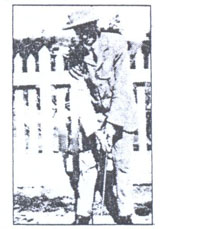 A. H. S. Clarke won his first title in 1907 in Nuwara Eliya, “Clarke as usual playing in a light holland coat: The explanation given at the time was that Clarke preferred to wear braces rather than a belt because he agreed with Harry Vardon that the golfer’s swing required a more controlling influence about the shoulders, and wearing braces he felt incumbent to hide them by wearing a coat !
A. H. S. Clarke won his first title in 1907 in Nuwara Eliya, “Clarke as usual playing in a light holland coat: The explanation given at the time was that Clarke preferred to wear braces rather than a belt because he agreed with Harry Vardon that the golfer’s swing required a more controlling influence about the shoulders, and wearing braces he felt incumbent to hide them by wearing a coat !
Governor Sir Henry Blake when presenting the Championship Cup had some interesting remarks to make: “Golf is a game in which mediocrity was easily obtained and excellence was a great pleasure, while perfection was a thing that was only known to a favoured few. It provided the most ideal muscular exercise without trespassing on the heart. Golf was played by the young man in the period of his adolescence and with a batt of clubs, and it might be played by the septuagenarian with nothing left to him but a cleek, an iron, a niblick his bunker language.”
Year 1908
The year witnessed a distinct improvement in the standard of golf in Ceylon, the game steadily attracting all classes. The best evidence was the better scores returned and the steady increase in the number of players who participated in the Competitions held in Nuwara Eliya and Colombo.
“The Island boasted of a greater number of out-standing Players than before ; F. A. Fairlie practically stood by himself in the ’80s, then came J. W. Gowar the early ’90s followed by H. C. Rose in the mid-90s and after him A. W. Watson, A. E. Ogilvy, C. Brooke- Elliot and J. G. Melrose. In 1908, in addition to the fc last-named, there were W. H. Smallwood, A. H. S. Clarke, R. B. Taylor, J. W. Erskine, E. C. Elliot, Step Brown, E. Human, George Cook, H. H. Phelp and others.”
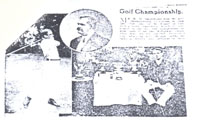 Perhaps the most noteworthy performance in 1908 was that of W. H. “Jungle” Smallwood, a Colombo player, whose form eclipsed everything during the year, although most of his successes were recorded at the Ridgeway Course.He did not take part in the Easter Tournament at Nuwara Eliya, but in June, Smallwood distinguished himself by some remarkable performances. Playing in the Burdett Trophy, “he beat the Nuwara Eliya player, H. H. Phelp 12 up in the first round of 18 holes with a score of 74”. He equalled this performance in the same month when he won the Club Gold Medal with 74, breaking the record of 79 held by George Cook, set the year before. He crowned his achievements by winning-the Championship too in the same month.
Perhaps the most noteworthy performance in 1908 was that of W. H. “Jungle” Smallwood, a Colombo player, whose form eclipsed everything during the year, although most of his successes were recorded at the Ridgeway Course.He did not take part in the Easter Tournament at Nuwara Eliya, but in June, Smallwood distinguished himself by some remarkable performances. Playing in the Burdett Trophy, “he beat the Nuwara Eliya player, H. H. Phelp 12 up in the first round of 18 holes with a score of 74”. He equalled this performance in the same month when he won the Club Gold Medal with 74, breaking the record of 79 held by George Cook, set the year before. He crowned his achievements by winning-the Championship too in the same month.
“The September Meeting in Nuwara Eliya was chiefly notable for the number of Service players who took part, Admiral Sir George Warrender also being a Competitor. Included in the programme was a Com¬petition for a handsome Silver Cup, presented by F. M. Elliot, a visitor from Singapore, for the best aggregate nett medal score over two rounds. No less than 170 cards were taken out, and Smallwood went up from Colombo especially for the event. He made the best rounds 75,75 but his +2 handicap put him out. The Cup was won by Captain C. R. Mills of the R. A. M. C. with scores of 90 & 90, his handicap of 18 giving him a nett 144.
Two other trophies were presented that year. In October, The Governor, Sir Henry McCallum presented a handsome Silver Challenge Cup for a Competition to be held at the Christmas Meet, and Colonel Sylvester presented The Sylvester Vase, another trophy which is played for to this day. Archie Aitken in his Memoirs in the C.G.U. Souvenir of 1958 writes : “I have always understood that Colonel Sylvester, R. A. M. C., when his time was up, left behind him a pony and trap and a brace of guns to be sold and the proceeds spent in the purchase of a Cup and Replica. It was first played for in 1908. Replicas became too expensive, so now a Club Prize is given.”
Year 1909
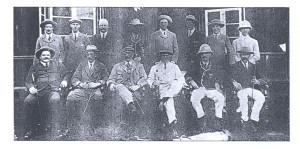 The Tournament in January 1909 was held on a lavish scale. The Annual Championship played at Nuwara Eliya during Easter saw A. H. S. Clarke win the title for the second time, when he beat H. T. Gibson Craig in the final. But the main attraction was the meeting of Smallwood and Clarke. Clarke had beaten Smallwood 7 up in the second round of the Burdett Trophy after Smallwood had scraped home one up in the first round, Clarke’s putt for a half at the 18th being spoilt by a bad bit of turf. They met in the second round of the Championship and Clarke won on the 19th after a terrific struggle. There were many who thought that Clarke was lucky, as Smallwood had thrown away two chances. But it was Clarke’s magnificent play in the second round of the Burdett against Smallwood that was regarded as one of the finest displays of Golf on the Nuwara Eliya Course. George Cook, Agent to the National Bank, went around the new extension in a record 72.
The Tournament in January 1909 was held on a lavish scale. The Annual Championship played at Nuwara Eliya during Easter saw A. H. S. Clarke win the title for the second time, when he beat H. T. Gibson Craig in the final. But the main attraction was the meeting of Smallwood and Clarke. Clarke had beaten Smallwood 7 up in the second round of the Burdett Trophy after Smallwood had scraped home one up in the first round, Clarke’s putt for a half at the 18th being spoilt by a bad bit of turf. They met in the second round of the Championship and Clarke won on the 19th after a terrific struggle. There were many who thought that Clarke was lucky, as Smallwood had thrown away two chances. But it was Clarke’s magnificent play in the second round of the Burdett against Smallwood that was regarded as one of the finest displays of Golf on the Nuwara Eliya Course. George Cook, Agent to the National Bank, went around the new extension in a record 72.
Year 1911
A telephone service that had been established in Nuwara Eliya in 1909, was connected to Colombo at Kandy in 1911. One wonders if the Club made use of this amenity! An interesting item regarding the telephone appeared in the 1st April 1889 issue of The Times of Ceylon : “One of the latest innovations and improvements in Nuwara Eliya is the connection of the White coach office with The Club (presumably Hill Club) and Grand Hotel by telephone. Up to now, it had taken seven coolies two hours to bring a rickshaw . Now you just had to pick up the phone and order one which arrived within minutes.”
Burdett Trophy
An important change in the conditions governing the Competition for the Burdett Trophy was made at the Annual General Meeting in 1911. The Resolution which had already had the approval of the Colombo Golf Club was that the results of the singles and foursomes should be decided by matches, not by holes, as this form of scoring “was the method which was maintained in golfing countries, and that they were all aware that International matches were decided by matches and not by holes.” In the eight years that the Burdett Trot had been played, it had been won four times by Colombo and four times by Nuwara Eliya, each team triumphing on its own Course. Colombo registered a 2 total of 240 holes to Nuwara Eliya’s 125, the biggest defeat being when Nuwara Eliya lost to Colombo in 1910, 66 holes to 9.
The first contest for the Trophy under the new conditions took place in Nuwara Eliya and was won Nuwara Eliya, 61/2 matches to 21/2 matches. This contest is of particular interest as it is the first one in which A. R. “Archie” Aitken (who went on to become the G.O.M. of Ceylon Golf) took part. Aitken won both the singles and, partnered by Clarke, the foursomer Aitken who had come from Scotland with a high reputation proved his class when he figured in the Championships for the first time and succeeded in getting into the finals where he had to face Clarke. Aitken held his own in the morning round, but Clark was invincible in the afternoon and won 4 and 3. Sir Hugh Clifford who was Acting Governor at the time met with some success in the September Meet when receiving the Westward Cup, he jocularly mentioned that Government Servants were not allowed to accept pieces of silver, and that in place of the piece of silver he was taking out of the Club, he would like to present a Cup to be won outright at the Christmas Meet, and would like it called the Lady Clifford Cup.
Year 1912
We are not sure when electricity was installed in the Club, but in 1912, electric lighting was introduced to Nuwara Eliya.
The Easter tournament of that year was the largest and one of the most successful held by the Club. The fact that there were 72 entries for one event alone was a record in itself, but this was eclipsed by the all-round excellence of the Golf. In previous years, nett scores of 90 and thereabouts secured places in the qualifying rounds, but that year, even 80s failed to qualify. The dry weather had not affected the greens as was usual in past years, and this was attributed to the establishment of a Water Service to every green by means of pipes at a cost of nearly Rs. 1,800. An uplift was given to the Game just before the meet by a new record established by J. L. Humphries of Singapore, who went round, — in a private game, — in 67.
Buchanan Cup
The Buchanan’s Cup, still played for, was presented to the Club that year. An article appearing in the C.G.U. Souvenir stated that Joe Lister who lived in Nuwara Eliya and was the Agent for Buchanan’s Whisky, persuaded them to donate a Cup and a Replica. Lister as a badge of office, always wore a black and white pearl tiepin. Sometime afterwards, a Buchanan’s traveller on his rounds called at the Club and was informed that there was no Buchanan’s Whisky in stock as there was no demand for it — the replica was promptly stopped.
Professional
In the middle of the year, C.J. Steer was brought out to Ceylon to become the professional at the Nuwara Eliya Golf Club. Steer, a professional from Sunning- dale, was a man of small stature, but nevertheless a great golfer. He had just, prior to his coming out to Ceylon, beaten Harry Vardon’s record for the Ganton Course near Scarborough, and it did not take him long to establish a Course record at Nuwara Eliya with a remarkable score of 60. Steer was responsible very largely for improving and extending the Course as it existed then.
Year 1913
“Ours is essentially a progressive Country, and the term applies equally to our Sports and Pastimes as to our Business methods and capacity. In all departments of Sport, the year 1913 has seen abundant improvement and the standard of proficiency in most games has been appreciably raised. Golf is no exception to this, and the quality of the Royal and Ancient game was never higher here than it is at present”. Thus wrote F. H. Hawkes, Captain of the Colombo Golf Club, who was runner-up to A. H. S. Clarke when the latter won his 4th title in Nuwara Eliya. He attributed this improvement to the advent of good players and the improved facilities for play.
1913 saw the advent of one or two other golfers of note, among them L. Vidler, the Oxford golfer, and it was said that each succeeding year’s Championship , secured a larger and better entry. The Championships held in Nuwara Eliya during Easter had nearly 30 entries, “among whom were men who had held, and could have still held, high places in golf at home”.
The “Times” of 19th April reports, “Baron E. Von Goldschmidt-Rothschild spent several days in Nuwara Eliya and played golf daily on the links with two American lady visitors”. An excellent move made in 1913 was a Resolution for the formation of a Golf Association of Ceylon. For the first time, the Burdett Trophy which took place in Nuwara Eliya ended in a tie, it being the first time that Colombo escaped defeat on the Nuwara Eliya course.
The year ended with terrible floods in Nuwara Eliya, “The Times” reporting, “One thought that the Nuwara Eliya course would not be ready for the festivities at Christmas, so lots of people stayed back in Colombo. Later a telegram arrived from Nuwara Eliya to say the course will jolly well be playable and eventually it was …”
Boslowick
Sometime after 1923 when “Boslowick” was purchased, the ladies were given a room in an outer building which also housed the Pro Shop and the office and record room, but their position in the Golf Club was rather vague. A system of handicapping them had been discussed by the Men’s Committee and they were allowed into the Men’s Pavilion during the tournaments. Of interest is that in 1931 and 1932, the first Ceylonese lady golfer in Nuwara Eliya, Miss Constance Goonewardene competed in a handicap event at the Club partnering her father, A. F. Goonewardene who was one of the early members of the Club.
United Club merger
It was only in 1935 when the discussions regarding the merger between the N.E.G.C. and the United Club started taking place, that a Ladies’ Section of the Club was formed. At a Special General Meeting of the Club held on 18th May, the Rules were drawn up and Mrs Gresham Johnson was elected the first President with Mrs C. G. Thornton, the first Captain of the Ladies’ Section. Archie Aitken in his reminiscence recalling this period says,“it was when the United Club closed its doors that the ladies joined in”.
Puffin Cup
 in 1936, C. M. “Puffin” Lushington, in recognition of this new status presented a Cup for the team matches that had hitherto been played between Nuwara Eliya and Colombo. The Cup was engraved with the words “Keep your head down — Don’t Press” and the competitions were played on the same lines as the Burdett. The first Puffin Cup was played in Nuwara Eliya and was won by Up-country. The matches were keenly contested. They were an important event in the ladies’ golfing calendar, with players from both Clubs striving for the honour of playing for their team.
in 1936, C. M. “Puffin” Lushington, in recognition of this new status presented a Cup for the team matches that had hitherto been played between Nuwara Eliya and Colombo. The Cup was engraved with the words “Keep your head down — Don’t Press” and the competitions were played on the same lines as the Burdett. The first Puffin Cup was played in Nuwara Eliya and was won by Up-country. The matches were keenly contested. They were an important event in the ladies’ golfing calendar, with players from both Clubs striving for the honour of playing for their team.
The last match before the war was in 1939 and ended with Up-country winning three of the four competitions played in that period. The series was resumed in 1948 when it was held at the Royal Colombo for the first time (the previous matches being played at the Lady Ashmore course when the event was held in Colombo). Colombo won, but when it was held in Nuwara Eliya the next year, Nuwara Eliya swamped Colombo, winning all 12 matches.
Year 1960 -1988
The British leave
With the exodus of the British, the number of resident members dwindled to one or two and any ladies’ competitions that were held thereafter were supported by the Colombo members who were members of the Royal Colombo Golf Club.
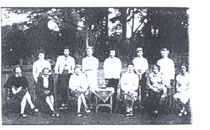 According to the Boards that hang in the Ladies’ Room, Mrs. Beadon was elected Captain in 1958. The years 1959 – 1976 bear the legend “Not elected”, but the names of the winners of the Captain’s Cup appear during this period against the years 1959— 1962, suggesting some discrepancy. Even the Minutes of the AGMs of N.E.G.C. shed no light as to whether or not a Lady Captain existed, but refers to a “Ladies’ House Committee convener” during those years.
According to the Boards that hang in the Ladies’ Room, Mrs. Beadon was elected Captain in 1958. The years 1959 – 1976 bear the legend “Not elected”, but the names of the winners of the Captain’s Cup appear during this period against the years 1959— 1962, suggesting some discrepancy. Even the Minutes of the AGMs of N.E.G.C. shed no light as to whether or not a Lady Captain existed, but refers to a “Ladies’ House Committee convener” during those years.
The last Puffin Cup was held in 1961, and in the 18 matches played in the series, each Club won an equal number of times. An attempt to revive it was made in 1974 when those with holiday homes in Nuwara Eliya played for Nuwara Eliya, but interest in the event waned, and the competition was abandoned. The Cup now lies, unpolishec and unplayed for, in the Store Room of the Nuwara Eliya Gc Club, a reminder of the glorious team matches of the past.
Ladies’ Championships
The Ceylon Ladies’ Championships, except for the years 1968 and 1970, was held and continues to be held in Nuwara Eliya on alternate years. It is now run by the Sri Lanka Ladies’ Golf Union, and held at the same time as the Men’s Championship.
The first Sri Lanka Ladies’ Stroke Play Championship was held in Nuwara Eliya in 1975, when Tiru Fernando outclassed the other competitors to bring in a record score of 220 for 54 holes. The Club Championship was not played for in 1959 and 1960 and has been held sporadically since then — in fact, only eight times in the last 30 years. The last time it was played for was in 1983.
There was a minor revival in the early 1980s when, for a few years, the wives of golfers from Skanska and Balfour Beatty companies, who were engaged in the Mahaveli Projects, made a fortnightly trip on weekends to the Club. There were only one or two competent golfers amongst them, but what they lacked in golfing ability was made up by their keeness, and a Ladies’ Committee was formed with Lalini Fonseka as the Captain.
An innovation in the 1980s has been the Open Amateur Stroke Play Championship of Nuwara Eliya, which has been d regularly, despite the poor entries in some years. The first winner was Mrs.S. Selvaratnam
Queen Sirikit Cup
Ladies golf in Sri Lanka reached its climax with the holding of the Asian Amateur Team Championship for the Queen Sirikit Cup. This event was held in Nuwara Eliya in 1982. The course was lengthened by the construction of new tees at some holes, while at others. play was from the Men’s tees. Teams of three from nine countries took part.
Ladies Golf Union
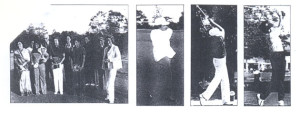 The Club still maintains its affiliation with the Ladies’ Golf Union through the Sri Lanka Ladies’ Golf Union. After the holding of the Queen Sirikit Cup, it was decided to retain some of the new tees; thus lengthening the course which remains at LGU SS 72. In the absence of a Ladies’ Committee and of any records, we continue this report through the memories of some of its members, past and present.
The Club still maintains its affiliation with the Ladies’ Golf Union through the Sri Lanka Ladies’ Golf Union. After the holding of the Queen Sirikit Cup, it was decided to retain some of the new tees; thus lengthening the course which remains at LGU SS 72. In the absence of a Ladies’ Committee and of any records, we continue this report through the memories of some of its members, past and present.
